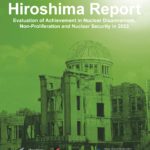2. Left in the Evacuation Area
The total number of children in Hiroshima City just before the bombing was 41,638 13.
During the war, the Japanese government implemented group evacuations for all public elementary school students from third to sixth grades. The government also designated 13 cities to be evacuated, including Tokyo and Osaka, in July 1944. Hiroshima was added to the list in April, 194514. The students of Ootemachi Elementary School (closed after the bombing) and other schools went to the northern part of the prefecture as the first evacuation group on April 3rd. It was said that 8,365 children evacuated to temples and assembly halls in seven towns in the prefecture, and attended local schools. In addition, nearly 17,400 students evacuated to relatives’ homes in suburban areas. Approximately 3,300 students who remained with their parents died15.
Because of the end of the war, on August 30th, Hiroshima City published a notification to school principals (“Concerning Evacuated Schoolchildren”) that the group evacuations had ended16. Students of Hiroshima Public Elementary School, attached to Hiroshima Normal School for Men (present-day Shinonome Elementary School, attached to Hiroshima University) left the evacuation area on September 4th. Students from a total of 36 evacuated schools ended group evacuation status in November. However, there were children who wanted to return, but could not, as they had lost their families, and had no place to go.
A fourth grade student of Nakashima Public School (present-day Nakashima Elementary School in Naka-Ward) wrote notes, which were gathered by the Hiroshima Institute for War Children, titled “Left in Evacuation Area,” written one year after the atomic bombing17. These notes were kept by the boy. These are the first notes about the atomic bomb experience in Hiroshima to frankly depict the atomic bomb damage. Following are quotations:
“The group evacuation has finally ended. My friends were steadily picked up by their fathers, mothers, uncles, or aunts. However, my father and mother didn’t come, no matter how many days I waited. In October, I suddenly received a letter from my relatives in Asa Mura (present-day Asaminami Ward), saying that my father and mother and my youngest sister were in Hiroshima and had been killed in the horrible atomic bombing. I was sad. My older brother and I didn’t know what to do. I couldn’t sleep, recalling memory after memory of my younger brother. Soon after I received the letter, all the students left in Futami-Gun were transferred to a branch of Izumo Shrine in Mirasaka. One month later, on December 28th, we moved to this institute for war children.”
His elder brother, in the sixth grade, who was evacuated to Futami-gun, Mirasaka-machi (present day Miyoshi City), and his younger brother, were also moved to the Institute for War Children.
His father had been a repairer of paper for screen doors and scrolls, and his family had lived in Tenjin-cho, Hiroshima City, (currently south of Hiroshima Peace Memorial Park). His parents and younger brother and younger sister evacuated to Furuichi-cho (present-day Asaminami Ward), but the boy, who turned 82 in 2017, said that, “It is still unclear where my father [then 45 years old], my mother [36 years old at the time], and younger sister [1 year old] died.”
12 students from Nakashima, Honkawa, Fukuromachi, and Hirose Public Schools, who had been evacuated to Mirasaka-cho, arrived at the Institute for War Children, placed in the-then Municipal Agricultural Experiment Station in Itsukaichi-machi (present-day Minaga, Saiki Ward)18. Seven students of Ootemachi Public School arrived on the 23rd from Yamanouchi Kita Son, Hiba-gun (present-day Shobara City), followed by 15 children from Hijiyama Camp for Lost Children on the 26th. However, Ootemachi Public School remained closed because few residents had returned to the area.
Those students who stayed in Hiroshima Institute for War Children began to be known as “orphans of the atomic bomb.”
13 Hiroshima City Office (ed.), Shinshu Hiroshimashi Shi Dai 4kan (New History of Hiroshima City vol.4), Hiroshima City, 1958, p640, Hiroshima Genbaku Sensaishi Dai 4 Kan (Hiroshima City History of Atomic Bomb Damages Vol. 4), p5
14 The Education Ministry, Gakusei Hyakunen Shi (Century History of Educational System), Teikoku Chihou Gyousei Gakkai, 1972, p567
15 Shinshu Hiroshimashi Shi Dai 4kan (New History of Hiroshima City vol.4), p640
16 Hiroshima City Education Center (ed.), Hiroshima-shi Gakkou Kyouiku Shi (Hiroshima Educational System History), Hiroshima City Education Center, 1990, p620
17 Hiroshima Institution for War Children, Ano Touji (At That Time), August 1946, owned by an individual
18 Hiroshima Institution for War Children, Nisshi (Journal), December 23, 1945-End of March, 1948, owned by an individual






